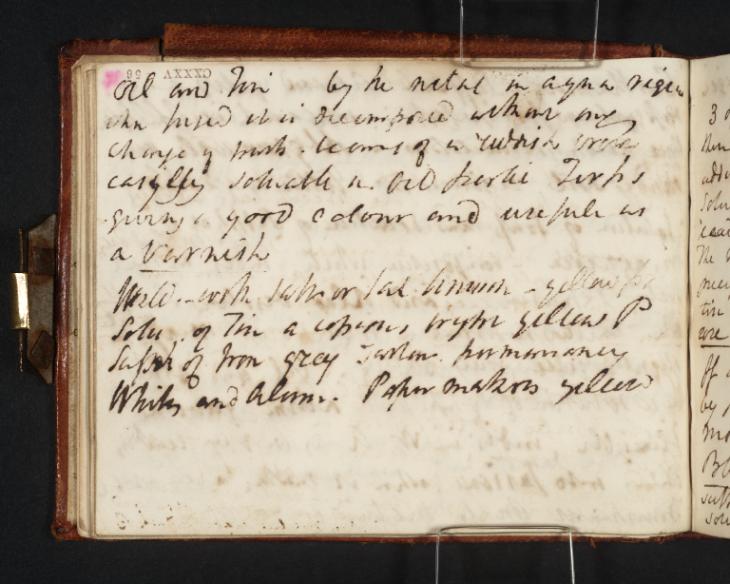Joseph Mallord William Turner Inscription by Turner: Notes from Nicholson's 'Dictionary of Practical and Theoretical Chemistry' c.1813
Joseph Mallord William Turner,
Inscription by Turner: Notes from Nicholson's 'Dictionary of Practical and Theoretical Chemistry'
c.1813
Joseph Mallord William Turner 1775–1851
Folio 56 Recto:
Inscription by Turner: Notes from Nicholson’s ‘Dictionary of Practical and Theoretical Chemistry’ c.1813
D09961
Turner Bequest CXXXV 56
Turner Bequest CXXXV 56
Pencil on white wove paper, 88 x 113 mm
Inscribed by Turner in ink with notes on chemistry (see main catalogue entry)
Inscribed by John Ruskin in red ink ‘56’ top left, upside down
Stamped in black ‘CXXXV – 56’ top left, upside down
Inscribed by Turner in ink with notes on chemistry (see main catalogue entry)
Inscribed by John Ruskin in red ink ‘56’ top left, upside down
Stamped in black ‘CXXXV – 56’ top left, upside down
Accepted by the nation as part of the Turner Bequest 1856
References
1862
Walter Thornbury, The Life of J.M.W. Turner, R.A. Founded on Letters and Papers Furnished by his Friends and Fellow-Academicians, London 1862 [1861], vol.I, p.359.
1897
Walter Thornbury, The Life of J.M.W. Turner, R.A. Founded on Letters and Papers Furnished by his Friends and Fellow-Academicians: A New Edition, Revised with 8 Coloured Illustrations after Turner’s Originals and 2 Woodcuts, London 1897, p.475.
1909
A.J. Finberg, A Complete Inventory of the Drawings of the Turner Bequest, London 1909, vol.I, p.385, CXXXV 56, transcribing part of inscription.
1992
Joyce H. Townsend, ‘Turner’s Writings on Chemistry and Artists’ Materials’, Turner Society News, no.62, December 1992, p.7, with transcription.
2011
Matthew Imms, ‘Not “quite out of his province”? Some New Identifications of Turner’s Working Notes’, Turner Society News, no.116, Autumn 2011, p.4, with partial transcription.
Most of the page is taken up with notes on chemistry in relation to colour:
Oil and Tin by the metal in aqua regia | when fused it is decomposed without any | change of parts. becomes of a purplish brown | easily soluable in Oil partic Turps | giving a good colour and useful | as a Varnish
Weld – with salt or Sal Ammon – yellow pt | Solu of Tin a copious bright yellow P | Sulph of iron grey Tartar permanency
White and Alum. Paper makers yellow
Joyce Townsend did not establish the origin of these notes, and was unable to throw any light on the first process. The second relates to weld, ‘a yellow organic pigment, with an iron mordant’ (i.e. fixative).1
This is one of fourteen pages of notes on varnishes and colours resulting from chemical reactions between folio 62 verso (D09974) and folio 55 recto (D09959), working from the back of the sketchbook as now foliated. Thornbury noted ‘paper-maker’s yellow’ among his potted transcriptions from these passages.2 As discussed in the sketchbook’s Introduction,3 most are taken from William Nicholson’s 1808 Dictionary of Practical and Theoretical Chemistry; here Turner’s first paragraph is the unpaginated entry on ‘Soap’:
The combination of oil and tin was made by means of the solution of this metal in aqua regia. It is white, not fusible when exposed to heat like all the other oleo-metallic combinations, but it is decomposed without any change in the form of its parts. ...
The oleo-ferruginous combination is of a reddish brown colour, tenacious, and easily fusible. When spread upon wood it sinks in and dries. It is easily soluble in oil, more particularly oil of turpentine, to which it gives a good colour, which may prove useful as a varnish.
There are further notes from the ‘Soap’ entry on the verso (D09962). The next paragraph is taken from the entry on ‘Weld’, a plant from which a yellow dye is extracted:
Solution of common salt, or of sal ammoniac, renders the liquor turbid, and its colour at first a little deeper; by degrees a deep yellow precipitate forms, and the supernatant liquor retains a pale yellow colour, a little inclining to green.
Solution of tin produces a copious bright yellow precipitate: the liquor remains a long time turbid, but slightly coloured.
Sulphat of iron produces a plentiful dark gray precipitate, and the supernatant liquor is brownish. ...
The yellow communicated to wool by weld has little permanency, if the wool be not previously prepared by some mordant. For this purpose alum and tartar are used, by means of which this plant gives a very pure yellow, which has the advantage of being permanent.
The last line gives the key ingredients of a recipe in the final paragraph of Nicholson’s ‘Weld’ article:
A water-colour, called weld-yellow, is much used by paper-hanging manufacturers. This is the colouring matter of weld precipitated with an earthy base. ... Into a copper vessel put four pounds of fine washed whiting and as much soft water, and boil them together ... then add gradually twelve ounces of powdered alum, till the effervescence ceases, and the whole is well mixed. Into another copper put any quantity of weld ...
Matthew Imms
April 2014
How to cite
Matthew Imms, ‘Inscription by Turner: Notes from Nicholson’s ‘Dictionary of Practical and Theoretical Chemistry’ c.1813 by Joseph Mallord William Turner’, catalogue entry, April 2014, in David Blayney Brown (ed.), J.M.W. Turner: Sketchbooks, Drawings and Watercolours, Tate Research Publication, September 2014, https://www

